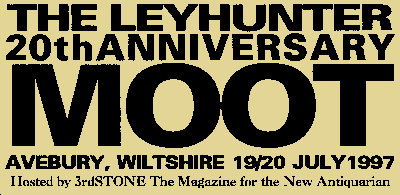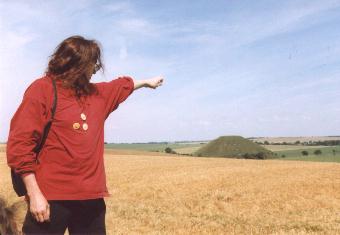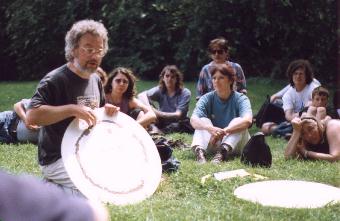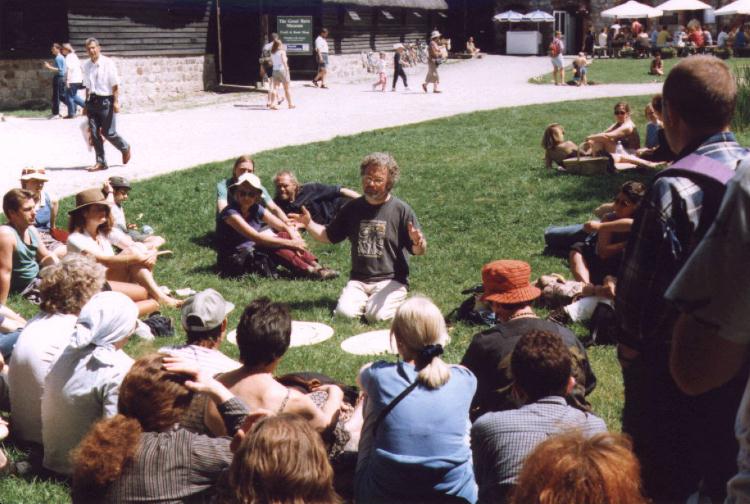


 The Ley Hunter Journal
(Click here to visit the official web site) is the longest running earth mysteries
publication in the world with an international readership. Danny Sullivan the current
editor, and one of the Moot organisers is pictured left pointing to Silbury Hill. Since 1977 TLH has organised an annual
conference or Moot for a weekend of talks and a field trip to an ancient sacred site.
Summer 1997 marked the twentieth anniversary of this venerable institution and we
celebrated this fact with a traditional weekend Moot centred around Avebury, in Wiltshire - the greatest and most well-known
Neolithic sacred landscape in the British Isles. On Saturday 19 July we gathered at the
Wessex Room in the Market Place at Devizes, 7 miles from Avebury for a feast of
illustrated presentations by acknowledged authorities on ancient sacred sites and their
functions, ceremonial landscapes, ancient world-views, anomalous aerial phenomena and
ancient astronomy. Hosted by 3rd Stone, the Magazine for the New Antiquarian
The Ley Hunter Journal
(Click here to visit the official web site) is the longest running earth mysteries
publication in the world with an international readership. Danny Sullivan the current
editor, and one of the Moot organisers is pictured left pointing to Silbury Hill. Since 1977 TLH has organised an annual
conference or Moot for a weekend of talks and a field trip to an ancient sacred site.
Summer 1997 marked the twentieth anniversary of this venerable institution and we
celebrated this fact with a traditional weekend Moot centred around Avebury, in Wiltshire - the greatest and most well-known
Neolithic sacred landscape in the British Isles. On Saturday 19 July we gathered at the
Wessex Room in the Market Place at Devizes, 7 miles from Avebury for a feast of
illustrated presentations by acknowledged authorities on ancient sacred sites and their
functions, ceremonial landscapes, ancient world-views, anomalous aerial phenomena and
ancient astronomy. Hosted by 3rd Stone, the Magazine for the New Antiquarian
 Paul
Devereux
Paul
Devereux
Consultant Editor of TLH, prolific author and lecturer in the UK
and USA, field researcher and founding Director of the Dragon Project Trust
Magical (Earth) Mystery Tour
In an astounding visual presentation Paul Devereux identifies highlights of the 30 years' journey from Earth Mysteries to, the new paradigms of cognitive archaeology and shamanic geography. Paul is pictured left discussing the view of Silbury Hill from West Kennett Long Barrow, and the surrounding sacred landscape.
Hear Paul Devereux speaking live at the Rollright Stones, February 5th 2000 |
Aubrey Burl
Author and archaeologist and acknowledged world authorith on prehistoric stone circles
Megalithic Avenues: Men on the right, women on the left
As enigmatic as stone circles are megalithic stone rows such as those of Camac. Dartmoor and the avenues of Avebury. An acknowledged authority on these monuments. Aubrey Burl examines many examples and the various explanations that have been put forward for their use, symbolism and meaning.
Jenny Randles
Professional ufologist, writer, broadcaster and lecturer
UFOs, naturally
A veteran researcher and acknowledged authority on UFOs, Jenny Randles takes a "feet on the ground" look at the phenomenon from her first hand experience. Are UFOs an unusual and unrecognised natural phenomenon - a product of atmospheric physics, optics, meteorology or geology.
Michael Dames
Artist and Geographer and author of the influential Avebury Cycle and The
Silbury Treasure
Ley - Lugh - Lay Lines
One hundred and fifty different ways to define a ley line and each of them equally true. The human imagination does not lie. Like a dream it just is. If knotted together, the various conceptions of ley lines might make a good net to trawl through cultures ancient and modem catching the substance and spirit of the Passing times. Or is it just ourselves thrashing about in the floor of the boat
 Robin
Heath
Robin
Heath
Editor of the Astrological Journal, published by the Astrological
Association
Sun, Moon and Megaliths - As Above So Below
Following in the pioneering footsteps of Professor Alexander Them. Robin Heath demonstrates the astronomical and geometrical knowledge built into megalithic sites, suggesting reasons as to why the history hooks refuse admission of this rnaterial at present. His fully illustrated talk is augmented by models and years of experience in megalithic achitecture. soli-lunar astronomy and as a lecturer in adult education. In the picture, Robin illustrates how Welsh stone circle Cerrig an Duon was constructed. He went on to demonstrate how it might have been laid out with ropes.
Most the views of most readers of the Ley Hunter and of mainstream archaeology seem to me to be converging, so I thought this report would be worthwhile. Most don't believe in energy lines, or straight tracks any more, but in the study of such linear features in the landscape such as death roads, and shamanistic spirit paths. I went to this event for the first time and was pleasantly surprised by the "sensible" level of the discussions. Over 150 people from the UK and abroad attended, marking a significant upturn in interest in the subject.
Robin Heath started with an introduction to the mathematics behind the calendar - asking the audience to think how days, weeks and months go to make up one year - not as obvious as it sounds. He went on to show how ancient man way have marked eclipses, and the relation of the sun and moon in the sky using the 56 Aubrey Holes at Stonehenge. He finished with an illuminating electronic demonstration of this theory with a model of the site.
Aubrey Burl was greeted with rapturous applause - and began by making it clear that he thought “sacred landscapes” were nonsense. He told how research at Carnac and elsewhere has shown that some stone rows were built up year-by year by successive generations, each wanting to make their mark on history. He suggested that the ordering of tall pointed stones, and shorter flat-topped stones is somehow related to male and female in ways we can only guess. His other main point was how avenues (double stone rows leading up to circles) taper as they get close to the circle entrance. This suggests that the circle builders wanted visitors to enter the circle with dignity and respect.
Michael Dames launched straight into a believable impersonation of Captain Mainwaring, from the well known TV series Dad’s Army. He did this to have a good humoured dig at the attitudes of "old school" archaeologists, reluctant to engage in “unhygienic” personal involvement with their subject. He took us back to the imagined mythology of his childhood, and how this had shaped his thoughts. He finished by emphasising the value of play, and of contact with Indian/African cultures to broaden one’s outlook away from the Western late 20th century.
Jenny Randles outlined her views on UFOs from a natural perspective. She showed how unusual, and sometimes unexplained, natural events can create UFO, or UAP (unexplained aerial phenomena) reports. Often the UFO and crop circle fraternity want to “spin” reports to match their pet theory (usually involving alien life forms). This then prevents the underlying phenomena being studied by scientists, who are wary of getting involved - a no-win situation. This, it was expressed later, is similar to how some "new-age" earth mysteries fanatics can prevent serious study of linear features in the landscape, as in “I’m not discussing anything to do with ley lines”.
Finally Paul Devereux rounded up twenty years of the LeyHunter Journal, re-visiting some original ideas, and bringing them up to date. He also appealed for help with plans for a trust to buy the Rollright Stones in Oxfordshire that are currently up for sale. Unfortunately his time ran out as he announced new and original research into archaic landscape lines in the Americas.
Several stands sold books, magazines and prints, and I gave demonstrations of Megaliths and Prehistory on the Web, with a computer loaded with some of the most interesting web sites on the subject I have found, including the official LeyHunter Journal web site.
Click here to visit the other web sites demonstrated.
On the second day the party was given a tour of the Avebury monuments by Paul Devereux and Michael Dames, and Robin Heath gave a practical demonstration of stone circle construction, with the party sitting on the grass outside The Great Barn. The overall "atmosphere" was refreshing and vibrant, showing the enthusiasm of those present to take a fresh look at a subject often entrenched in its own past.

Jump to the
official Ley Hunter Web Site


This site is not officially connected to The Ley Hunter journal, however the author Andy Burnham is a subscriber